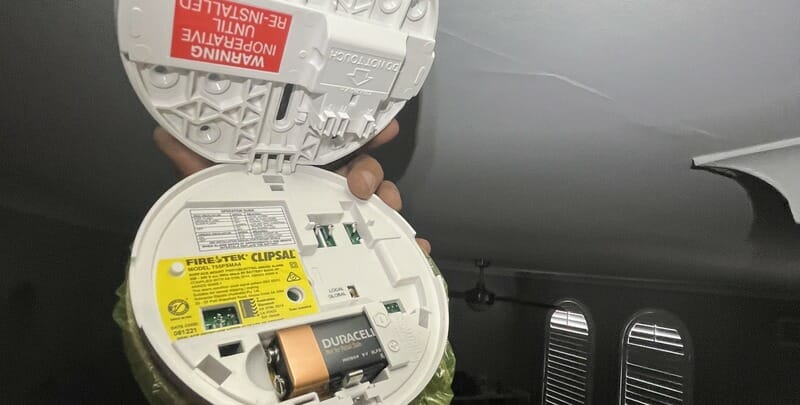
Smoke Alarms an Early Warning System
Ensuring the safety of our homes and loved ones is of paramount importance, and one crucial element in achieving this is having effective smoke alarms in place.
Smoke alarms serve as an early warning system, alerting us to the presence of fire or smoke before it becomes a life-threatening situation. But how many smoke alarms do we really need to adequately protect our homes?
Let’s explore the world of smoke detectors and consider the factors that determine the ideal number required for optimal safety. We will discuss the different types of smoke alarms available, the layout and size of your home, and the recommended placement guidelines.
Additionally, we will highlight the importance of regular maintenance and testing to ensure the functionality of your smoke alarms.
Crucial Factors to Consider
How many alarms do you need for your home? Several crucial factors should be considered.
Firstly, the size and layout of your home play a significant role. Larger homes may require multiple alarms to ensure comprehensive coverage. Additionally, the number of levels or floors in your house is important, as each level should ideally have its own smoke alarm.
Another critical consideration is the presence of bedrooms and sleeping areas. It is essential to have a smoke alarm installed near each sleeping area to provide early warning in case of a fire at night.
Following recommended placement guidelines is vital, as certain high-risk areas like kitchens and living rooms may require additional smoke alarms. They are the ultimate in fire protection.
By taking these factors into account, you can determine the appropriate number of smoke alarms needed to create a safe environment for you and your family.
Recommendations for Smoke Alarm Placement
Proper smoke alarm placement is key to ensuring effective coverage throughout your home. Consider the following recommendations when placing smoke alarms:
- For bedrooms and sleeping areas, it is crucial to have a smoke alarm near each room or in the hallway outside.
- Place alarms in living rooms and common areas, but not too close to heating appliances or fireplaces.
- Basements and attics should also have smoke alarms, as residential house fires can start unnoticed in these areas.
- In the kitchen, install alarms away from cooking appliances to minimise false alarms (aka nuisance alarms). Do not place smoke detectors in small kitchens.
- If needed, consider installing alarms in hallways and stairwells to provide escape routes.
- For attached structures like garages, a smoke alarm unit should be present.
Remember, interconnected alarms are highly recommended, so when one alarm sounds, they all sound, maximising early warning capabilities.
By strategically placing smoke alarms in these recommended locations, you can significantly enhance the safety of your home and increase your chances of early detection in the event of a fire. Read more about smoke detector regulations here.

Different Types of Smoke Alarms
It’s not just about the number of smoke alarms you have, but it’s also about the type. Different types of smoke alarms serve different purposes and understanding them can make your home safer.
- Ionisation smoke alarms: These alarms are excellent at detecting fast-burning, flaming fires. They contain a small amount of radioactive material that creates an electrical current when smoke particles enter the chamber. They are best suited for areas where you might experience a sudden, intense fire, like the kitchen.
- Photoelectric smoke alarms: Photoelectric smoke alarms use a beam of light to detect smoke particles. Photoelectric alarms are highly effective at sensing slow-burning, smouldering fires, like those caused by electrical faults or overheated wiring. Install these in your bedrooms and living areas. Interconnected photoelectric smoke alarms are highly recommended.
- Combination smoke alarms: These alarms combine both ionisation and photoelectric alarms to provide comprehensive protection. They’re a great choice if you want a single detector that can handle various fire types.
- Smart smoke alarms: These alarms connect to your smartphone and offer remote monitoring and alerts. Some can even communicate with other smart devices in your home for added safety.
In summary, having a combination of smoke alarms strategically placed throughout your home ensures you’re well-protected against different types of fires.
Most smoke alarms will do the job but always consider your specific needs and choose the right smoke alarms to keep your loved ones safe.
Smoke Alarm Maintenance and Testing
Maintaining and regularly testing your smoke alarms is crucial for their effectiveness. Follow these essential steps to ensure their proper functioning.
Test your alarms at least once a month by pressing the test button and verifying that the alarm sounds loud and clear. If the sound is weak or absent, replace the batteries immediately.
Speaking of batteries, they should be changed at least once a year (unless you’ve got a 10-year battery) or as recommended by the manufacturer. It is also highly recommended to have smoke alarms hard-wired to your electrical system.
It’s also important to keep the alarms clean and free from dust or debris, as these can interfere with their operation. Regularly vacuum or gently dust the alarms to maintain their sensitivity.
Remember to replace your smoke alarms entirely every 10 years or as advised by the manufacturer. If you have battery powered alarms, you must change the battery annually (unless you have a 10-year battery).
By diligently performing these maintenance tasks and staying proactive, you can have confidence in the reliability of your alarms and ensure their readiness to safeguard your home and loved ones in case of a fire.
Importance of Interconnected Smoke Detectors
Interconnected smoke alarms offer a higher level of protection for your home and occupants. This means all the alarms are interconnected so that when one detects smoke or fire, all alarms in the network will sound simultaneously.
This feature is critical in providing early warning throughout your entire house, ensuring everyone has ample time to evacuate safely.
With interconnected alarms, even if a fire starts in a remote part of the house, the alarm closest to you will alert you immediately, regardless of your location.
This interconnected system greatly enhances your chances of detecting a fire early, especially when you may not be in the same room as the initial source.
For optimal safety, it is recommended to have interconnected alarms installed in all areas of your home, including bedrooms, hallways, and common areas.
By investing in interconnected smoke alarms, you create a comprehensive safety net that significantly increases your ability to respond swiftly and protect your home and loved ones in the event of a fire. Speak to a professional technician about installing an integrated smoke detector system.

What are Wireless Smoke Alarms?
Wireless smoke alarms are a modern advancement in home safety that offer convenience and improved coverage.
Unlike traditional hardwired smoke alarms that require complex installation with wires running through your walls, wireless alarms communicate with each other and your central alarm system through wireless technology.
Here’s what you need to know about them:
- Easy installation: Wireless smoke alarms are a breeze to install. You can place them anywhere in your home without worrying about wiring or drilling holes. This flexibility makes it easier to ensure you have the right number of alarms in the right locations.
- Interconnected communication: These alarms talk to each other. When one alarm detects smoke, it sends a signal to all others in your home, triggering a simultaneous alert. This interconnectedness ensures that if a fire starts in one area, you’ll be alerted throughout your home, giving you more time to react.
- Remote monitoring: Many wireless smoke alarms can be connected to your smartphone or a central monitoring system. This means you can receive alerts and updates on your phone, even when you’re away from home, providing peace of mind.
- Battery backup: They often come with backup batteries in case of power outages, ensuring uninterrupted protection. It means you’ve always got a network of working smoke alarms in your home.
Wireless smoke alarms offer a convenient and effective way to enhance the safety of your home. Whether you’re upgrading your existing alarms or installing new ones, they’re a smart choice to consider.
Just remember to regularly test and maintain them to keep your family safe from fire hazards.
Additional Considerations and Tips
There are a number of other factors consider when installing smoke detectors, including:
- Integration with home security systems – Explore options for integrating your smoke alarms with a home security system. This allows for centralised monitoring and immediate notification to emergency services in case of a fire.
- Special considerations for i ndividuals with hearing impairments – Install alarms with visual or vibrating alerts for those who are deaf or hard of hearing. Consider interconnected alarms that trigger specialised devices like strobe lights or bed shakers.
- Periodic review and updating – Regularly review the placement and functionality of your smoke alarms. Update your alarms as needed, following advancements in technology or changes in your home’s layout.
- Emergency escape plan – Develop and practise an emergency escape plan with all household members. Assign roles and designate a meeting point outside the house for a safe rendezvous.
- Fire safety education – Educate yourself and your family members about fire prevention and safety measures. Teach children about the importance of fire drills and what to do in case of a fire.
By considering these additional tips and factors, you can further enhance the effectiveness of your smoke alarm system and increase overall fire safety in your home.
Put Your Family’s Safety First
There is no one-size-fits-all answer for how many smoke alarms are needed in a home.
However, by considering factors such as the size and layout of your home, the presence of bedrooms and following recommended placement guidelines, you can determine the ideal number of smoke detectors to ensure comprehensive coverage and early detection in the event of a fire.
Remember to regularly test and maintain your alarms, replacing batteries as needed, and keeping them clean from dust and debris. Consider installing interconnected smoke detectors to provide simultaneous alerts throughout your home, maximising early warning capabilities.
The key is putting your family’s safety first. If it’s appropriate, integrate smoke alarms with home security systems, accommodate special needs, and stay proactive with fire safety education and emergency escape plans. That way you can create a secure environment and be well-prepared to respond effectively in the face of a fire emergency.
Investing in the right number of smoke alarms and taking necessary precautions will provide you with peace of mind, knowing that you have taken important steps to protect what matters most.
Whether you need a single working smoke alarm or several wireless interconnected smoke alarms, you need the smoke detector experts at Mr Emergency. If you have any smoke alarm questions, we’re available 24/7, every day of the year. Contact us today.
Please note: This information is provided for advice purposes only. Regulations differ from state to state, so please consult your local authorities or an industry professional before proceeding with any work. See our Terms & Conditions here.


